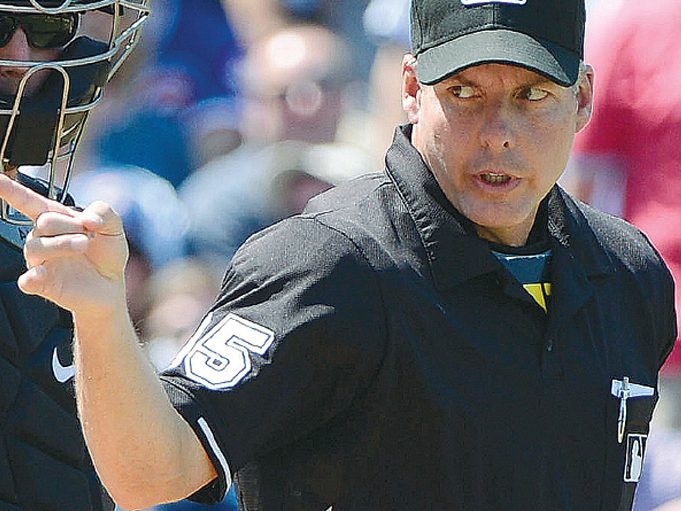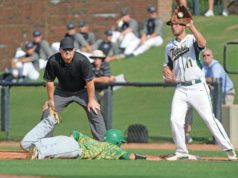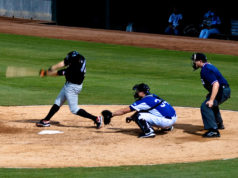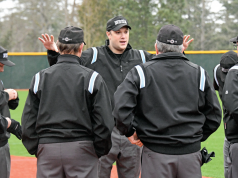On Aug. 16, 1920, in a game against the New York Yankees at the Polo Grounds, Cleveland shortstop Roy Chapman was hit in the head by a pitch thrown by Carl Mays and died 12 hours later. He remains the only MLB player to have died from being hit by a pitch. The sound of the ball smashing into Chapman’s skull was so loud that Mays thought it had hit the end of Chapman’s bat, so he fielded the ball and threw to first base.
No one accused Mays of deliberately throwing at Chapman, but the incident illustrates how dangerous throwing near batters can be. Intentionally trying to hit a batter is a despicable act and umpires should have no tolerance for such behavior. There is no act that justifies retaliation by throwing at an opponent.
More recently, there was a major brawl that included eight ejections during the early rounds of the 2013 World Baseball Classic between Canada and Mexico. The pitcher for the Mexican team, unaware that run differential was a tiebreaker in the Classic, intentionally threw at a Canadian batter following a bunt that led off the ninth inning. After missing on the first pitch, the Mexican pitcher threw at the batter a second time, at which point the umpires issued the official warning. When the pitcher finally hit the batter on the third attempt, it sparked the 10-minute melee.
In professional play, many pitchers believe that if one of their hitters has been hit by a pitch, intentionally or not, they have to “protect” their team by then throwing at an opposing batter. That approach is completely unacceptable in amateur play.
Intentional or not?
Whether a pitch thrown at a batter is intentional can be partially gauged by the skill level of the pitcher. The younger the players, the more tolerant umpires can generally be of erratic pitches. At the higher levels of play, pitches thrown behind a batter or at his head are more likely than not thrown there intentionally.
If a pitcher slips when he releases the pitch or the mound is slick, there should probably be less suspicion of ill intent. The umpire should also note if the pitcher previously exhibited good control or if he has been erratic the entire game. The type of pitch is also a significant indicator. A pitch destined to send a message is more likely to be at the top end of the speed spectrum and not a breaking ball that could have possibly failed to break.
Warning signs
Previous incidents should raise umpire antennas. An acrimonious incident earlier in the game might serve as ill-conceived grounds for retaliation. As previously indicated, all rationale for throwing at a batter is unjustified, is to be condemned and cannot be tolerated.
First and foremost is “eye for an eye” retaliation for a batter that was previously hit by a pitch. A hard collision or spiking may also generate ill will. The overall tone of the game should also be a consideration. Has it been a gentlemanly sporting contest or has there been bench jockeying and taunting?
In a recent prep playoff game, a runner who had grounded out stepped on the first baseman’s foot. The contact was slight and not noticed by the base umpire. When the first baseman returned to the dugout, he told his coach about it. The coach then approached the umpires about the incident, but his undiplomatic style made the umpires wary of his intent. Apparently, the coach did not like the umpire’s response to his complaint and soon a batter was hit. The end result was a bench-clearing brawl.
Additionally, there may be perfectly normal plays that launch negative thoughts. After a home run, the first pitch to the next batter should get the jaundiced eye of the plate umpire. Unusual home run trots and the exchange of words between pitcher and batter-runner are a glaring signal.
The penalty
Intentionally throwing close to a batter mandates a penalty of ejection (NFHS 6-2-3; NCAA 9-2g; pro 8.02d). Alternatively, the umpire may warn the pitcher if there is doubt concerning the pitcher’s intent. Please note the rule states “throwing close.” There is no requirement for a batter to actually be hit before the umpire may take action. Umpires must act without hesitation in enforcing the rule.
Without the certainty of intent, an immediate ejection should be avoided, but could be made if, in the umpire’s judgment, the situation warrants drastic action to defuse a potentially volatile situation. In cases where there is reasonable doubt as to the pitcher’s intent, the umpire may give a warning. In NCAA and pro, one warning serves both teams. However, in NFHS play, only the team that violates can be warned. Take this play, however, as an example of what can happen with just one team being warned.
Play: In an NFHS game, the home team’s pitcher hits the visiting team’s cleanup batter squarely in the back. Suspecting intent, but being unsure, the plate umpire correctly warns the home team. In the next half inning, the visiting team’s pitcher hits the first batter of the inning with a fastball squarely in the batter’s back.
Ruling: Even though the visiting team wasn’t warned, there should be no doubt of the intent of the visiting team’s pitcher. The pitcher should be immediately ejected.
In NFHS play, the pitcher is the only one ejected. In pro and NCAA, following a warning, if the pitcher is ejected, the head coach is also ejected.
Also, in NCAA and pro, the plate umpire can issue a warning at any time, including before the game if he suspects tensions are high. In NFHS play, a violation must occur before a warning can be issued.
What's Your Call? Leave a Comment:
Note: This article is archival in nature. Rules, interpretations, mechanics, philosophies and other information may or may not be correct for the current year.
This article is the copyright of ©Referee Enterprises, Inc., and may not be republished in whole or in part online, in print or in any capacity without expressed written permission from Referee. The article is made available for educational use by individuals.


















